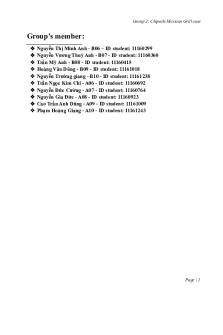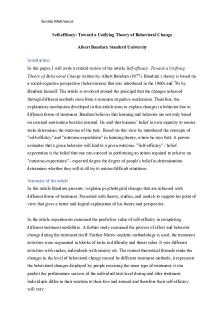JMD 205 LONG Lesson PLAN Individual Assignment PDF

| Title | JMD 205 LONG Lesson PLAN Individual Assignment |
|---|---|
| Author | Karabo Mphela |
| Course | business studies methodology |
| Institution | University of Pretoria |
| Pages | 8 |
| File Size | 551.8 KB |
| File Type | |
| Total Downloads | 108 |
| Total Views | 162 |
Summary
Long lesson planning can be difficult at times, so I sincerely urge you all to go thoroughly read this document attentively so. OPV...
Description
Long lesson planning form Student name and surname: N A R E K A R A B O
Student number: 1 9 2 8 7
M P H E L A
4
4
6
Programme: B.Ed
Lesson plan number:
PGCE
1
2018 Long Lesson Planning Form (PGCE and BEd) 1. SUBJECT: BUSINESS STUDIES 1.1. TYPE OF LESSON: (Tick the relevant box) Theory Experimental/laboratory Field work/practical Application Other (Specify): …………………………………………
1.2. DATE: 2 0 2 0 1.3. GRADE:
0
6
1
9
(Indicate with an X on the appropriate box) R
1
2
3
4
5
6
7
8
9
10
11
12
1.4. LENGTH OF PERIOD: 45 minutes 1.5. NUMBER OF LEARNERS: 30 1.6. TOPIC (from CAPS): 2. market environment The components of the market environment •The market (consumers/customers) •Suppliers •intermediaries • Competitors •Other organisations/civil society (e.g. community based organisations - CBOs, non-governmental organisations - NGOs, regulators, strategic allies and unions) • Opportunities and threats faced by the business - business has no control over these factors
2. KNOWLEDGE AREA (ONLY for Foundation Phase): (Tick the relevant boxes) Language, e.g. Listening and speaking Reading and phonics Writing and hand writing Language structure and use Creative writing
Mathematics, e.g. Numbers, operations, relationships Patterns, functions, algebra Space and shape (Geometry) Measurement Data handling
Life skills, e.g. Beginning knowledge (Natural Science, Social Science, Scientific processes, Technological process skills) Physical education Personal and social well-being Creative arts (Dance, Drama, Music, Visual Art)
3. INTEGRATION WITH OTHER SUBJECTS: (How does this lesson integrate with other subjects for cross-curricular teaching?)
Business Studies is a broad subject in the social sciences, allowing the in-depth of a range of specialties such as accounting, economics and human resource management and marketing. They all focus on a business as a whole and how their everyday operations affect the communities in which they operate on.
4. PRESCRIBED OUTCOMES: (from CAPS) 4.1. GENERAL AIMS: (List as many as are applicable, but rather concentrate on one or two for a lesson) The National Curriculum Statement (NCS) aims to produce learners who are able to (choose from CAPS (2011), page 4/5, section 1.3 (d)):
4.1.1. Identify and solve problems and make decisions using critical and creative thinking, work effectively as individuals and with other as members of a team.
4.1.2. Collect, analyse, organise and critically evaluate information, communicate effectively using visual, symbolic and/or language skills in various modes.
4.2. SPECIFIC AIMS:
4.2 INTEGRATED SKILL(S):
(List all the applicable aims that you wish to achieve through this lesson, from CAPS, approximately pp. 8–10)):
(If your subject is a LANGUAGE, indicate which of the four SKILLS, i.e. reading, writing, listening and/or speaking, you will focus on in this lesson, from CAPS):
4.2.1. ensure that learners acquire and apply essential business knowledge, skills and principles to productively and profitably conduct business in changing business environments.
Reading Writing
4.2.2. create business opportunities, creatively solve problems and take risks, respecting the rights of others and environmental sustainability.
4.3. TOPICS: Paste a copy of the applicable topics page you will deal with in this lesson, directly from CAPS. Ensure that you indicate the topic for this lesson in colour by highlighting, using a different colour, etc.
Listening Speaking
4.4 LESSON OUTCOME(S):
Formulate the lesson outcome(s) yourself, in your own words, as full sentence(s), based on the prescribed aims and topics/skills from CAPS (on the previous page) by completing the following sentences:
4.4.1. At the start of this lesson the learners should already know (state existing knowledge, skills and values) … the specific aims/purpose of Business Studies and understand how these specific aims/purpose will aid them in the future… and can use the resources provided for learning Business Studies effectively. 4.4.2. By the end of the lesson the learners should be able to… (state new knowledge, skills and values)
Explain what the Market Environment is and to distinguish between various components of market environment; they should be able to also understand how these components affect the business and community as a whole; lastly, they must be able to identify and solve the threats and the opportunities that the business might come across.
4.5 BRAINSTORMING AREA: (Use this area for rough planning and brainstorming on ideas for your lesson)
5. STUDENT TEACHER'S THEORETICAL APPROACH 5. 1. Learning theory/theories and paradigm/s (also called frameworks) (I believe that the learners will best achieve the lesson outcomes via… Indicate which learning theory and its related paradigm you chose. Also show how you will navigate among these theories and paradigms for the different phases and stages of the lesson) Learning theory Paradigm/framework Behaviourism Transmission Justify your choice(s): (because…) Cognitivism
Transaction
Constructivism
Transformation
Connectivism
Transcendental
Because the learners learn by processing the information given to them by their teacher and this will also enable them to become effective problem solvers.
5.2. Multiple intelligences (I addressed during this lesson…) Auditory/Musical/Rhythmic Visual/Spatial Verbal/Linguistic Kinaesthetic/Bodily
Interpersonal Intrapersonal Logical/Mathematical Naturalistic
Combination: (List them) _______________________________ _______________________________ _____________
Justify your choice(s): (because…)
Because most the learners learn effectively by listening to the teacher and working in groups, because they sometimes gain more knowledge by listening to their peer’s perspective.
5.3. TEACHING STRATEGIES AND TECHNIQUES (I used… to meet the lesson outcomes. Indicate how your choices here in 5.3 link to your choices in 5.1) Direct instruction (transmission): Question and answer Explanations Theory/model Drill work
Guided discovery: Inquiry-based learning Cooperative learning Pair work Small group work Role-play
Solving real life challenges (no guidance)
Combination: (Specify) _____________ _____________ _____________ _____________
Other: (Specify) _____________ _____________ _____________ _____________
Justify your choice(s):
The use of explanations links perfectly with my choice in 5.3 because by the teacher will explain the content to the learners and the learners will process the content and store it in their memories, this will also allow them to ask and answer questions and work effectively with other learners.
6. EVIDENCE OF LEARNING (Indicate your assessment strategies) 6.2 Purpose 6.1 Assessment instrument Baseline Portfolio Formative Observation Summative Worksheet Rubrics Tests Journal Project / assignment Other (specify):
Justify your choice(s): the teacher will teach the learners the content and observe how the learners use the information given to them.
Justify your choice(s): the teacher will use formative assessment because it is not judgemental, but rather focuses on providing constructive criticism and it turns weaknesses to strengths.
6.3 Method of assessment (The lesson will be assessed by…) Self Peer Educator Expert/s Parent Other educator/s
Justify your choice(s): the educator will assess the lesson.
7. LESSON PHASES: 7.1 THEME (Context; big idea): (What theme will you use to contextualise your lesson, link it to learners' real world and introduce your topic? Give your theme a short and inspiring name, e.g. “Friendships”, “Our amazing planet” or “Holiday destinations”)
“A company’s market environment consists of the factors and forces that affect the company’s ability to develop and maintain successful transaction relationship with its target customers”. 7.2 INTRODUCTION (Time allocated 10 min) (Capture attention create learning atmosphere, teacher-learner dialogue, awaken prior knowledge. Explain how you will use your theme in 7.1 to introduce the lesson)
The teacher will start the lesson by asking the learners what they understand/know about the subject “Business Studies”. The teacher will give the learners a brief history behind Business Studies. The teacher will initiate class discussion with the learners by asking them the following questions: 1) what is an environment? 2) what type of environment would you like to conduct your business in one day?. 7.3 DEVELOPMENT (Time allocated 20 min) (Continue teacher-learner dialogue to start with new knowledge, learner-centred activities, applicable content, consider questions to
guide learners towards critical thinking, show sequence of teaching events, scaffolding activities, etc.):
The teacher will outline the components of market environments, being customers/consumers, suppliers, intermediaries and competitors, to learners. The learners will engage in a discussion where they will be assessing an article from a newspaper about organisational/civil societies. The learners will individually name/mention organizational programmes that they know of from their communities. The learner will be given an article, about “gains from coal mine uncertain”, where they will be identifying/quoting anything that seem as opportunities and threats.
7.4 CONSOLIDATION (Time allocated 10 min) (Consider ways to ascertain that learners have achieved the outcomes, recapping of main teaching points, assessment, wrap up):
The teacher will give a brief summary of what was taught in the lesson (being market environment and its components). The teacher will compile questions for learners to answer after the lesson to assess the learner’s understanding of the content. The learners will also be granted the opportunity to ask questions after the lesson.
8. CLASSROOM MANAGEMENT (e.g. encouragement rather than control; climate of trust; responsibility in group work; etc.) Include: discipline measures
Withholding privileges Exclusion from group Climate of trust Being friendly, but business-like Conflict resolution
9. LEARNER ENRICHMENT (What measures are in place for gifted learners?)
Allow gifted learners to assume ownership of their own learning through curriculum acceleration. Provide opportunities for gifted learners to interact with other gifted learners across grade levels and schools through competitions or collaborative projects. Make the curriculum student centred.
10. LEARNER SUPPORT (What measures are in place if a learner has special educational needs?) Include: curriculum differentiation
Adapted curriculum: lessons and assessments will be modified to ensure success for all. Multiple intelligence: every learner is different. The learners will be given the opportunity to learn in a manner that best suit their needs and learning styles.
11. LTSMs (Educational media) (Name LTSMs used in lesson and reference ALL your resources under Bibliography/List of references. Pay attention to the variety, relevance, effectiveness and applicability of the LTSM you selected for the lesson).
Textbooks Articles PowerPoint slides
12. Bibliography (abridged Harvard method) of All sources consulted (e.g. Smit, L. 2011. Teaching. Pretoria: Van Schaik)
…2012. Curriculum and Assessment Policy Statement (CAPS): Business Studies Grade 10-12. Department of Education.
13. REFLECTION OF LESSON PRESENTED (NB: Please note that this section can only be completed AFTER the critique lesson has been presented and/or AFTER reflection with the assessor) Use the following reflection questions as a guide to … A. Write a narrative essay reflection on your lesson. OR B. Answer all the questions with full sentences. Reflection questions: 1. What did I pay attention to during my planning that contributed to the success of my lesson? 2. What did I overlook or forget to pay attention to? 3. Did my introduction grab the learners' attention and link the new knowledge to their everyday lives? 4. Did my introduction progress according to my expectations; what could I have done differently? 5. Did my lesson progress according to my expectations? 6. What difficulties did I encounter during my lesson; what could I have done differently? 7. How did I establish whether, and to what extent, learners had achieved the lesson outcomes? 8. What did I do well and what could I improve on?
1. 2. 3.
4. 5. 6.
I paid attention to the theme of this lesson because that’s what led to the completion and success of this lesson. Nothing was forgotten when planning this lesson. Yes, I think that my lesson introduction grabbed the learner’s attention and of course it did link the new knowledge to their everyday life. For example, in the introduction the learners where asked about the type of environment that they would like to conduct their business on, this enable them to check out business opportunities in their environment and what type of business can be conducted. Yes, my introduction did progress according to my expectations and I personally think there’s nothing I could have done differently. No, my lesson did jot progress according to my expectations. Planning this lesson was kind of difficult for me because I didn’t know how to cater for learners with special educational needs.
FULL NAME: NARE KARABO MPHELA
DATE: 21 JUNE 2020
STUDENT NUMBER: 19287446
CONTACT NUMBER:
0794700723 TOPIC OF WORK: LONG LESSON PLAN
DECLARATION: 1. I understand what plagiarism is and are aware of the University’s policy in this regard. 2. I declare that this assignment is my own, original work. Where other people’s work has been used (either from a printed source, Internet, or any other source) this has been properly acknowledged and referenced in accordance with departmental requirements. 3. I have not used work previously produced by another student or any other person to hand in as my own. 4. I have not allowed, and will not allow, anyone to copy my work with the intention of passing it off as his or her/their own work.
SIGNATURE: SNARE...
Similar Free PDFs

Lesson Plan Assignment 2
- 5 Pages

5e Lesson Plan - assignment
- 6 Pages

205 Reading Assignment
- 2 Pages

Individual Assignment
- 26 Pages

Individual Assignment
- 20 Pages

Individual assignment
- 5 Pages

Individual assignment
- 3 Pages

Lesson Plan
- 8 Pages

205 Reading Assignment Name
- 3 Pages

Lesson 13 Long Run Equilibrium
- 13 Pages

Lesson plan
- 5 Pages

Unit 8 Assignment 1 Lesson Plan
- 14 Pages
Popular Institutions
- Tinajero National High School - Annex
- Politeknik Caltex Riau
- Yokohama City University
- SGT University
- University of Al-Qadisiyah
- Divine Word College of Vigan
- Techniek College Rotterdam
- Universidade de Santiago
- Universiti Teknologi MARA Cawangan Johor Kampus Pasir Gudang
- Poltekkes Kemenkes Yogyakarta
- Baguio City National High School
- Colegio san marcos
- preparatoria uno
- Centro de Bachillerato Tecnológico Industrial y de Servicios No. 107
- Dalian Maritime University
- Quang Trung Secondary School
- Colegio Tecnológico en Informática
- Corporación Regional de Educación Superior
- Grupo CEDVA
- Dar Al Uloom University
- Centro de Estudios Preuniversitarios de la Universidad Nacional de Ingeniería
- 上智大学
- Aakash International School, Nuna Majara
- San Felipe Neri Catholic School
- Kang Chiao International School - New Taipei City
- Misamis Occidental National High School
- Institución Educativa Escuela Normal Juan Ladrilleros
- Kolehiyo ng Pantukan
- Batanes State College
- Instituto Continental
- Sekolah Menengah Kejuruan Kesehatan Kaltara (Tarakan)
- Colegio de La Inmaculada Concepcion - Cebu



